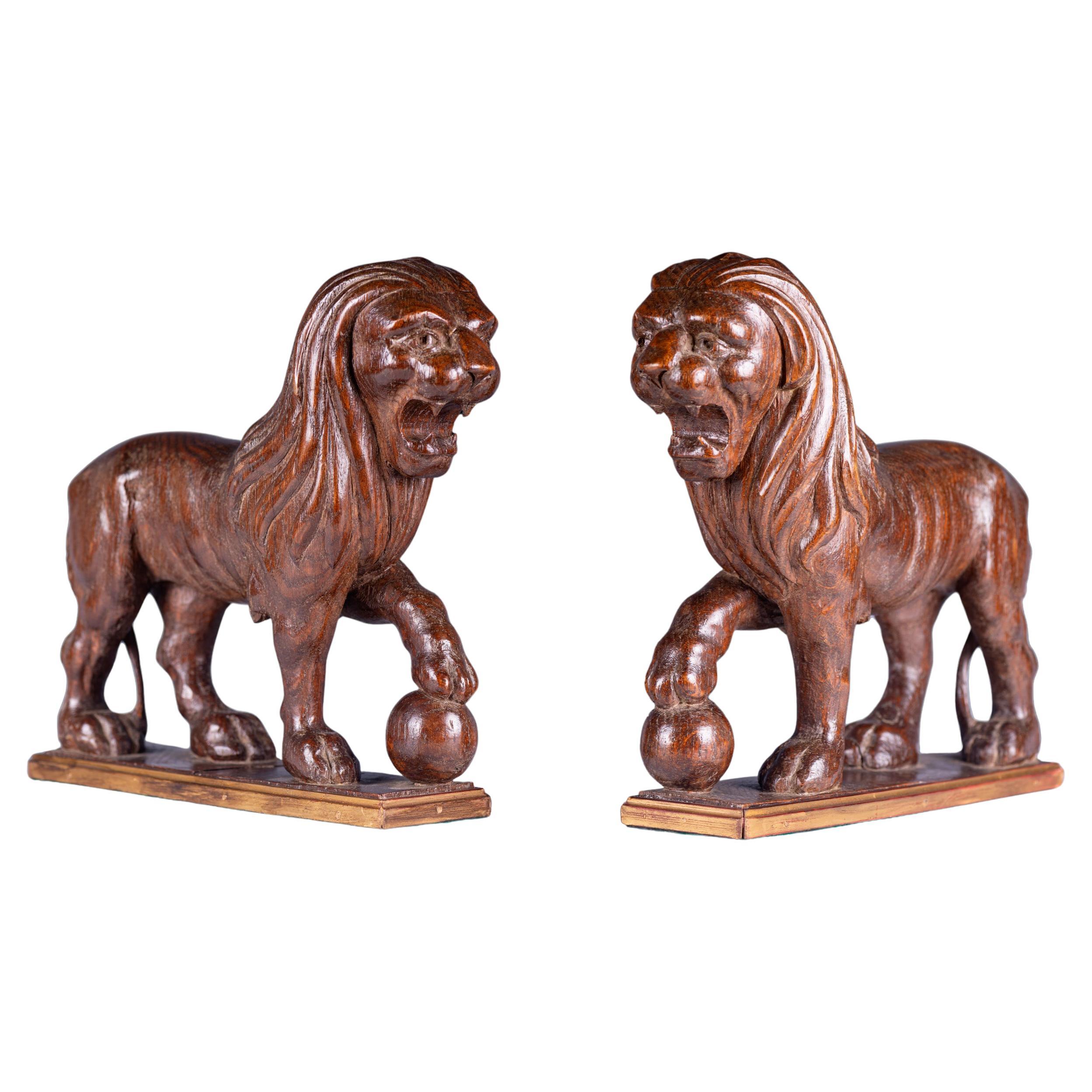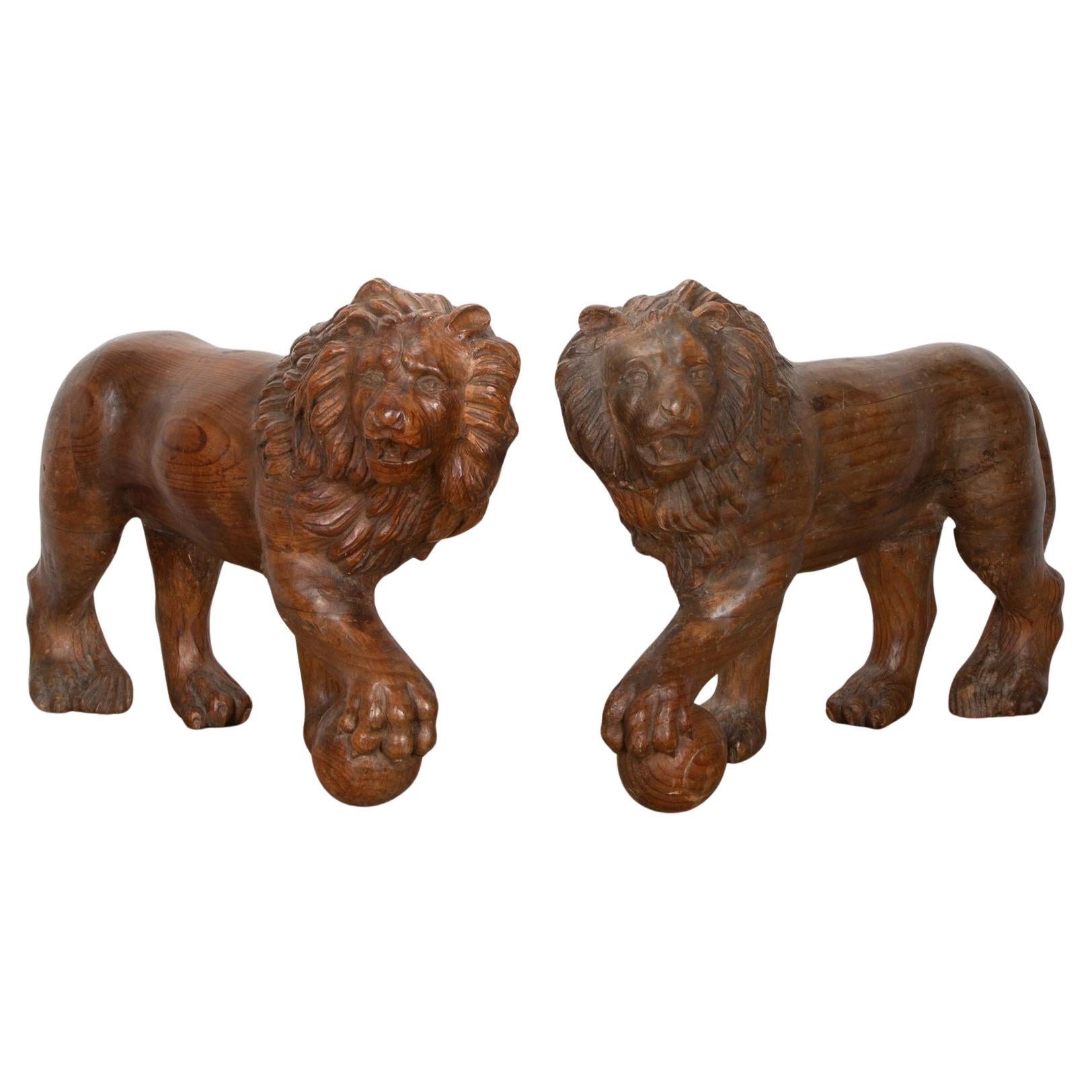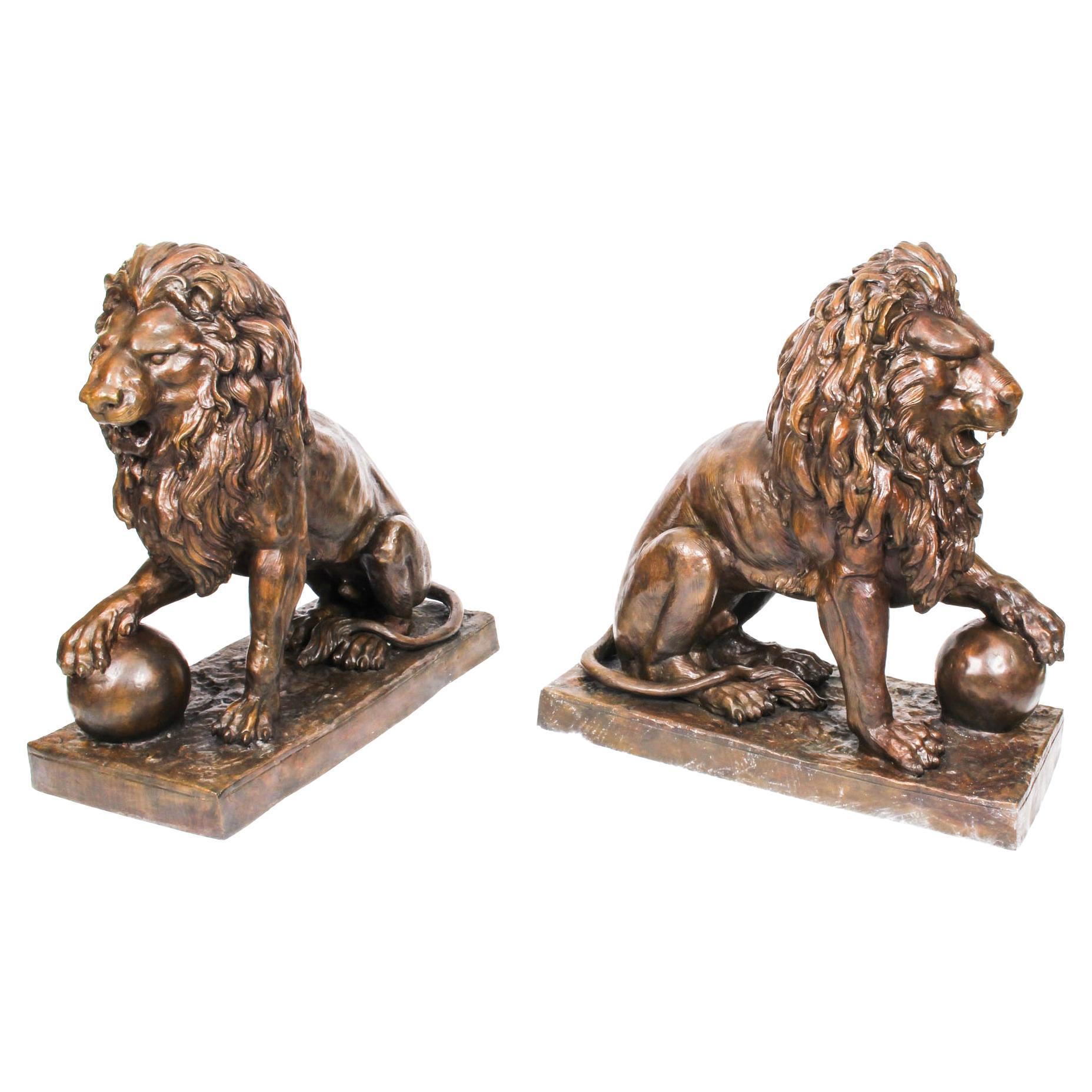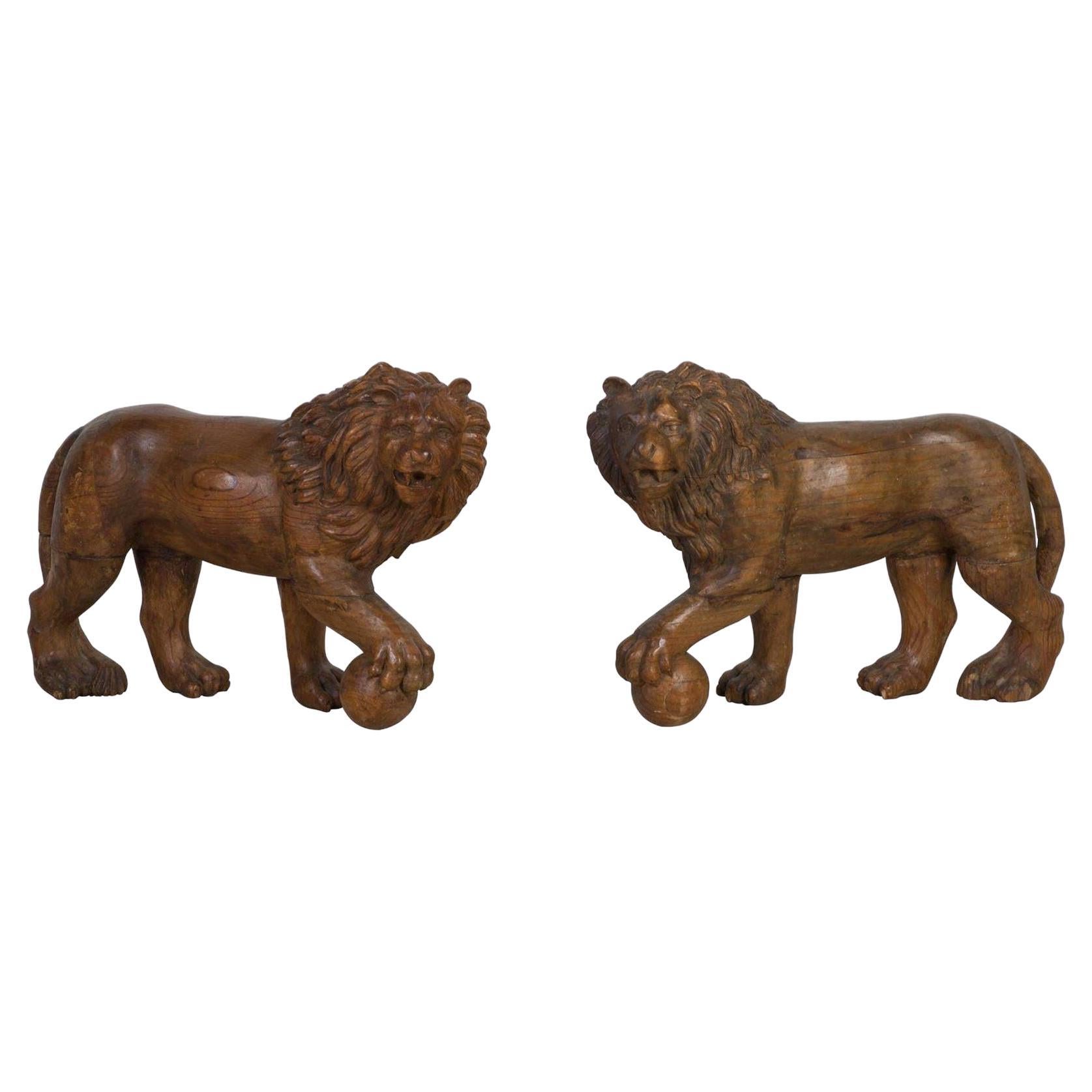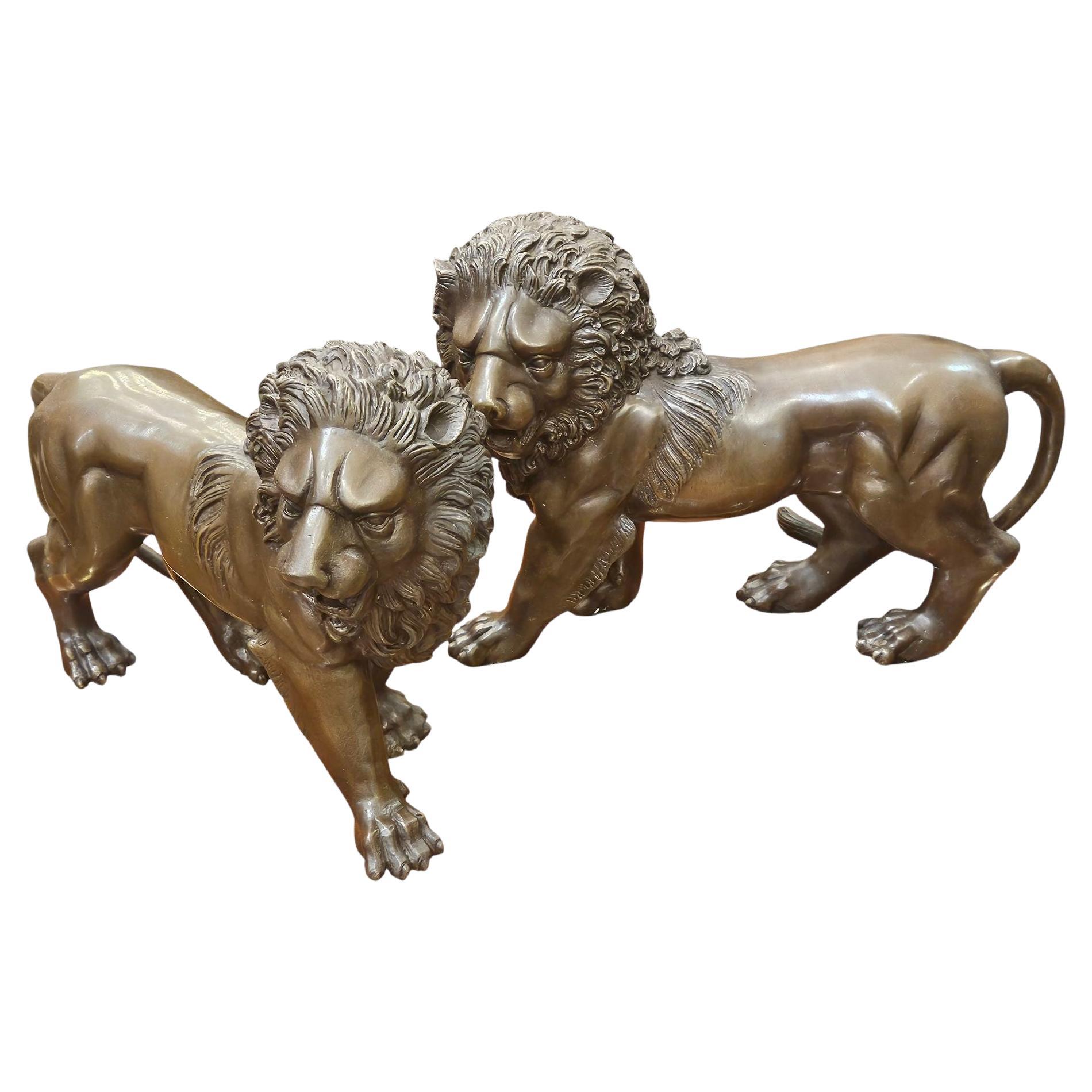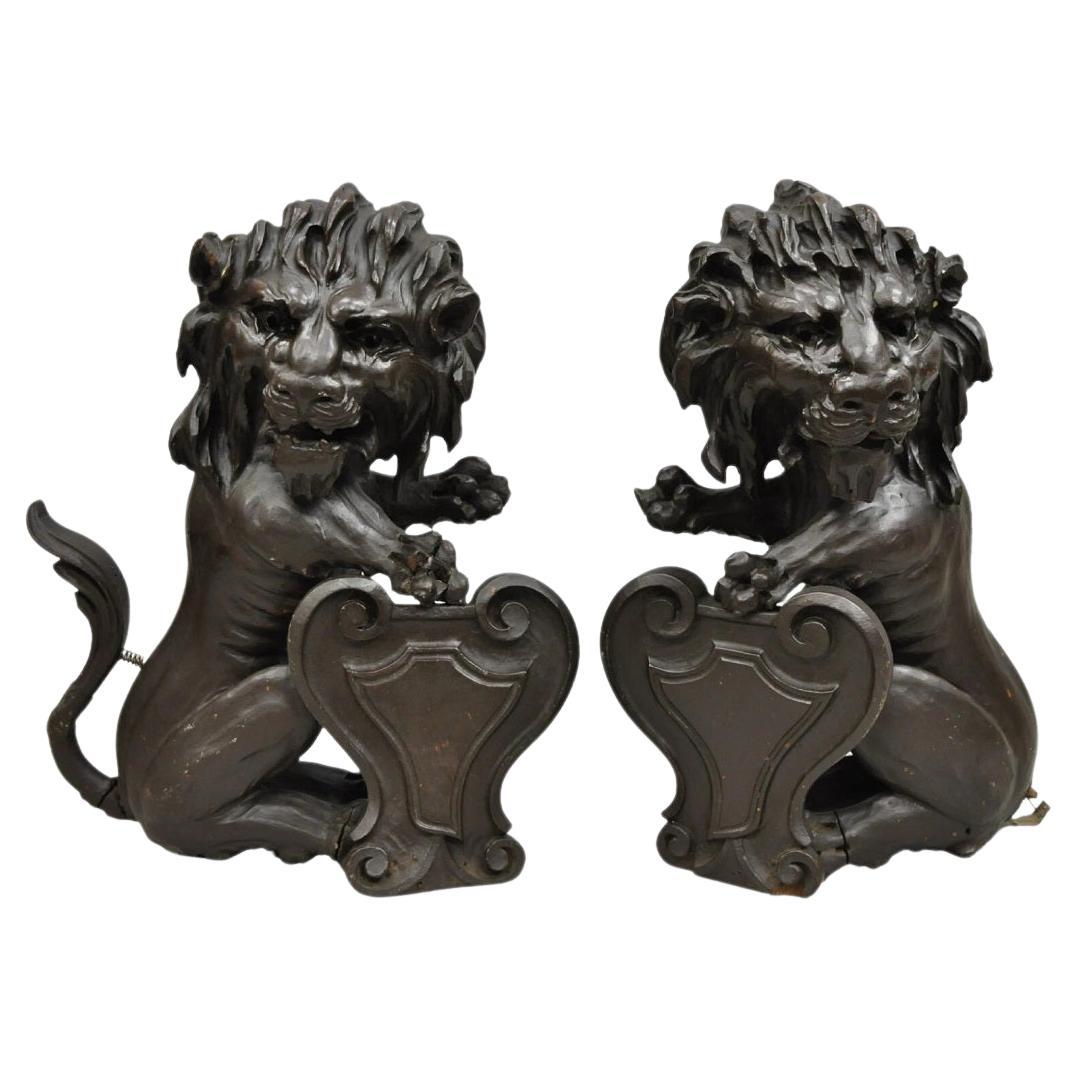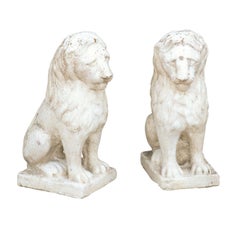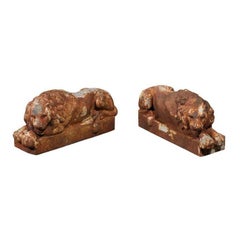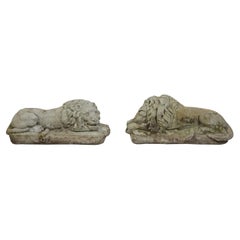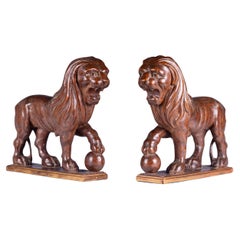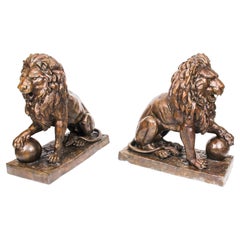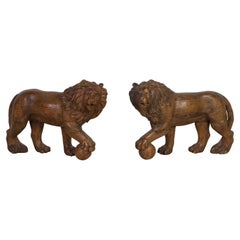Items Similar to Pair of Italian 1880s Small Walnut Hand Carved Lion Sculptures with Dark Patina
Want more images or videos?
Request additional images or videos from the seller
1 of 14
Pair of Italian 1880s Small Walnut Hand Carved Lion Sculptures with Dark Patina
$7,995per set
£6,177.52per set
€7,141.80per set
CA$11,297.51per set
A$12,670.91per set
CHF 6,635.56per set
MX$153,963.94per set
NOK 84,260.50per set
SEK 79,884.89per set
DKK 53,309.80per set
About the Item
A small pair of Italian walnut hand carved roaring lion sculptures from the late 19th century, with dark patina. This pair of Italian walnut hand-carved roaring lion sculptures from the late 19th century exudes a sense of regal alertness. Crafted with meticulous attention to detail, each lion sits in a poised, yet relaxed position, their powerful bodies conveying readiness and vigilance. The rich dark patina enhances the lifelike quality of these sculptures, emphasizing the finely detailed manes and expressive facial features. The lions' tails are elegantly tucked to the side, further accentuating the naturalistic approach taken by the artist.
Born in Italy circa 1880, these sculptures showcase the skilled craftsmanship of the period, capturing the essence of these majestic creatures with a remarkable realism. The lions' musculature is subtly rendered, giving the impression of latent power, while their slightly open mouths and intense gazes convey a sense of impending action.
With their small proportions, these sculptures are versatile decorative pieces, perfect for adding a touch of classical elegance to any space. Whether placed atop an enfilade, chest-of-drawers, or console table, they will bring a touch of Italian artistry and a hint of the wild to your home. These walnut lion sculptures are not only a testament to the skill of 19th-century Italian carvers but also a timeless addition to any collection of fine art or antiques.
- Dimensions:Height: 12.25 in (31.12 cm)Width: 5 in (12.7 cm)Depth: 16 in (40.64 cm)
- Sold As:Set of 2
- Materials and Techniques:
- Place of Origin:
- Period:
- Date of Manufacture:circa 1880
- Condition:Wear consistent with age and use. Please refer to the various additional photos for further condition detail and contact us with any questions!
- Seller Location:Atlanta, GA
- Reference Number:Seller: F 100221stDibs: LU836714145911
About the Seller
5.0
Platinum Seller
Premium sellers with a 4.7+ rating and 24-hour response times
Established in 1988
1stDibs seller since 2007
1,422 sales on 1stDibs
Typical response time: 1 hour
- ShippingRetrieving quote...Shipping from: Atlanta, GA
- Return Policy
Authenticity Guarantee
In the unlikely event there’s an issue with an item’s authenticity, contact us within 1 year for a full refund. DetailsMoney-Back Guarantee
If your item is not as described, is damaged in transit, or does not arrive, contact us within 7 days for a full refund. Details24-Hour Cancellation
You have a 24-hour grace period in which to reconsider your purchase, with no questions asked.Vetted Professional Sellers
Our world-class sellers must adhere to strict standards for service and quality, maintaining the integrity of our listings.Price-Match Guarantee
If you find that a seller listed the same item for a lower price elsewhere, we’ll match it.Trusted Global Delivery
Our best-in-class carrier network provides specialized shipping options worldwide, including custom delivery.More From This Seller
View AllPair of Petite French Mid Century Modern Lion Sculptures on Bases
Located in Atlanta, GA
This pair of petite French lion sculptures from the mid 20th century features two lions made of composition, peacefully sitting on a base. Depict...
Category
Mid-20th Century French Animal Sculptures
Materials
Composition
Pair of Petite French Patinated Iron Reclining Lions, Turn of the Century
Located in Atlanta, GA
This petite pair of French iron sculptures from the turn of the century (19th to 20th) features two reclining lions, peacefully resting on a rectangular base. A lot of attention has ...
Category
Early 20th Century French Animal Sculptures
Materials
Iron
Pair of English 1920s Cast Stone Reclining Lion Sculptures on Conforming Bases
Located in Atlanta, GA
A pair of English cast stone reclining lions statues from the early 20th century, on rectangular bases. Created in England during the first quarter of the 20th century, each of this ...
Category
Early 20th Century English Animal Sculptures
Materials
Cast Stone
Italian Carved and Painted Wooden Sculpture of a Lion from the Early 1800s
Located in Atlanta, GA
An Italian carved and painted wood lion from the early 19th century. How not to be charmed by this exquisite painted lion, who almost seems to be smiling? The sculpture mixes a touch...
Category
Antique Early 19th Century Italian Animal Sculptures
Materials
Wood
19th century Victorian English Cast-Iron Lion Doorstop with Old Red Patina
Located in Atlanta, GA
A cast iron lion doorstop from Victorian England. This 19th century Victorian cast-iron flat-back reclining lion is an elegant doorstop, probab...
Category
Antique Late 19th Century English Animal Sculptures
Materials
Iron
English Brass Lion Sculpture from the Late 19th Century in Reclining Position
Located in Atlanta, GA
An English brass lion sculpture from the late 19th century, in a reclining position. Born in the later years of the 19th century, this English bra...
Category
Antique Late 19th Century English Animal Sculptures
Materials
Brass
You May Also Like
Pair of 19th Century Italian Grand Tour Carved Walnut Medici Lions on Plinths
Located in Dublin, IE
An impressive and expressive pair of 19th-century hand-carved lions, each depicted standing with one paw resting on a sphere—symbolizing dominion and power. The figures are finely mo...
Category
Antique 19th Century Italian Grand Tour Animal Sculptures
Materials
Walnut
19th Century Carved Pair Medici Lions
Located in Gloucestershire, GB
19th Century pair medici lions in carved wood, at opposing stances with heads turned to sinister and dexter, with one paw on a ball.
Circa 1830.
Category
Antique 1830s Animal Sculptures
Materials
Wood
$5,816 / set
Vintage Magnificent Large Pair of Cast Bronze Medici Lions Late 20th Century
Located in London, GB
This is a historically interesting bronze sculpture of a pair of lions after the original Medici Lions placed at the Villa Medici, Rome. This pair dating from the second half of the 20th Century.
The lions are sitting on their haunches with one front paw on a sphere, and they are facing right and left with their tails on opposite sides. They feature beautifully toned muscles and sleek detailed manes, which signifies their masculinity and reflects their health.
This high-quality hot cast solid bronze pair was produced using the traditional "lost wax" process, otherwise known as the "cire perdue" method.
It is a majestic pair which will look lovely equally at home indoors or outdoors.
Condition:
In excellent condition, please see photos for confirmation.
Dimensions in cm:
Height 96 x Width 43 x Depth 95
Dimensions in inches:
Height 3 foot, 2 inches x Width 1 foot, 5 inches x Depth 3 feet, 1 inch
Lost Wax Method
sometimes called by the French name of cire perdue or the Latin, cera perduta is the process by which a bronze or brass is cast from an artists sculpture.
In industrial uses, the modern process is called investment casting. An ancient practice, the process today varies from foundry to foundry, but the steps which are usually used in casting small bronze sculptures in a modern bronze foundry are generally quite standardised.
The Medici lions are a pair of marble sculptures of lions, one of which is Roman, dating to the 2nd century AD, and the other a 16th-century pendant; both were by 1598 placed at the Villa Medici, Rome. Since 1789 they have been displayed at the Loggia dei Lanzi in Florence. The sculptures depict standing male lions with a sphere or ball under one paw, looking to the side.
Copies of the Medici lions have been copied and publicly installed in over 30 other locations, and smaller versions made in a variety of media; Medici lion has become the term for the type.
The Albani lion, a similar ancient sculpture, now at the Louvre
A similar Roman lion...
Category
Vintage 1970s Animal Sculptures
Materials
Bronze
Large Pair of C19th Grand Tour Carved Medici Lions
Located in Shipston-On-Stour, GB
A large and rare C19th pair of `Grand Tour` Medici lions in carved wood, at opposing stances with heads turned to sinister and dexter, with one paw on a ball. Circa 1830. In good co...
Category
Antique 1820s Italian Neoclassical Animal Sculptures
Materials
Pine
Pair of Bronze Medici Lions
Located in London, GB
A Lovely Pair of Medici Bronze Lions
Lovely Patina and Definition
C20th
Category
Late 20th Century Unknown Renaissance Animal Sculptures
Materials
Bronze
$942 Sale Price / set
20% Off
Antique Renaissance Revival Carved Oak Wood 20" Lion Architectural Elements Pair
Located in Philadelphia, PA
Antique Italian Renaissance Revival Carved Oak Wood 20"Lion Figures, Architectural Elements - a Pair. Item features right and left forms with carved lions holding a shield. Circa Lat...
Category
Antique Late 19th Century Unknown Renaissance Revival Animal Sculptures
Materials
Oak
More Ways To Browse
Patina Italy
Antique Lion Sculpture
Pair Of Carved Lions
Small Carved Animals
Hand Carved Lion Table
Lion Italian Sculpture
Dark Walnut Console
Antique Animal Console Table
Italian Enfilade
Horse Metal
Mid Century Bird Sculpture
19th Century Horn
Equestrian Furniture
Bird On Stone
Horse Model
Head Metal Sculpture
Antique Lion Sculpture
Folklore Furniture
